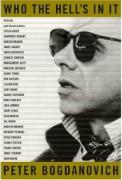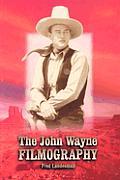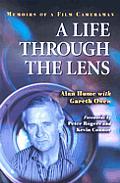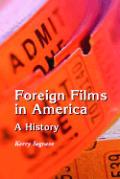Welcome to a new feature here at DVDTalk that we hope to bring you every six weeks or so. There are a lot of books out there about the movies -- biographies, filmographies, references and histories -- some of which may not be as visible as others. We're going to review an interesting cross-section of new and recent books we think you'll find interesting. Let's get started!
 Who the Hell's In It
Who the Hell's In It by Peter Bogdanovich (Alfred A. Knopf, $35) Though the director of
The Last Picture Show,
Saint Jack, and
They All Laughed has of late been reduced to lurid TV biopics, as a writer Bogdanovich is still near the very top of an ever-growing heap. Who'd have thought there was anything new to say about such over-written film stars as Brando, Chaplin, Dietrich, Monroe and Sinatra? Yet somehow, every "portrait and conversation" overflows with insight and little observations by the author, who'll take note of defining quirks and gestures which speak volumes. Except for Humphrey Bogart, Bogdanovich had at least some interaction with each of the 25 stars profiled. Often he directed them in a movie or spent years developing a project for them that for one reason or another never got made. He became pals with some, fleetingly met others, but in all of the portraits he zeroes in on their appeal, the reasons for their enduring popularity and our undying fascination for them. A brief essay on Montgomery Clift offers a touching and telling anecdote about the time Bogdanovich met him while working at a New York revival theater. The actor's reaction to a "request book" in the lobby, to an entry in block red letters stating "ANYTHING WITH MONGOMERY CLIFT," says more about the tragedy of that actor's life than many full-blown biographies. Similarly, a brief, humble speech by Lillian Gish on cinema is as profound an expression on "the sacred ideal of the medium" as any I've ever heard. There's a wonderful variety to these portraits; some actors' offscreen personae come out of lengthy interviews, in which Bogdanovich's pointed questions and phenomenal memory and eye for little details ingratiates him with his subjects, who open up in ways that are often surprising. He captures the loneliness of Dietrich, the frailty of Chaplin, the zest-for-life giddiness of Cary Grant, and the surprising affability of Brando early in his career. A book like this is a real treasure; when stars like Jimmy Stewart, Henry Fonda, and Cary Grant were still around, Bogdanovich was one of the few good writers who also happened to be a film buff and historian, as well as a rising talent in his own right. Too many biographies and video documentaries try to mold the human being into their onscreen image (like fashioning Jimmy Stewart the actor into a George Bailey of Beverly Hills), or dig up dirt, push it front-and-center as an expedient way to sell books. Bogdanovich's work makes human beings, flaws and all, of our favorite stars, while simultaneously paying tribute to the deeply personal, sometimes profound impact they've made on all of us, and will continue to do so long after we, too, are gone.
 The John Wayne Filmography
The John Wayne Filmography by Fred Landesman (McFarland, $75) Expensive but handsomely done work offers meaty, alphabetized entries (nearly 450 pages worth) on the actor's 170+ films., from 1937's
Adventure's End to 1939's
Wyoming Outlaw. Entries include release date, running time, cast, distributor, and crew. Landesman quotes from a wide range of reviews for each film and offers detailed synopses. A notes section includes production dates, negative costs (including Wayne's salary, and often that of the director and supporting players), a list of locations, and biographical sketches of key personnel. Welcome appendices include a listing of Wayne's films in order of release, a huge list of unrealized projects and those that went ahead with another actor, a list of his box office successes and, intriguingly, a ranking of television network airings of Wayne's films, complete with airdate and Neilsen rating. This is a very useful reference, particularly for its synopses, reviews, budgets, and shooting dates. There are lots of great photographs, and the detail given Wayne's minor B-Westerns and pre-star missteps is commendable. The work falls short in other areas, however. Although it includes detailed entries on movies where Wayne appears only an unbilled extra, it completely omits features Wayne produced in the 1950s but did not star in (
Track of the Cat,
Gun the Man Down, etc.). The cast lists include the actors' names only, not the characters they play, though some are identified in the synopses. Also disappointing is the omission of any core technical information: wide screen formats (CinemaScope, VistaVision) aren't identified -- entries often don't even indicate whether the film is in color or black and white. Still, overall this is an impressive effort, and a must-have for Wayne fans.
 Memoirs of a Film Cameraman: A Life Through the Lens
Memoirs of a Film Cameraman: A Life Through the Lens by Alan Hume with Gareth Owen (McFarland, $35) Cinematographer Hume's career is certainly worthy of a book length study. His work is both diverse and far-reaching, and like Ronald Neame before him Hume's ouvre is like a mini-history of the British film industry. Among his credits, first as a clapper boy, then as an operator and finally a full-fledged DP:
In Which We Serve,
Oliver Twist, most of the
Carry On series, a couple of Hammer films,
The Avengers TV series, a documentary on the 1972 Olympics made in collaboration with Kon Ichikawa, the Kevin Connor/Edgar Rice Burroughs fantasies, a couple of James Bond movies, and
A Fish Called Wanda. How then with these credits could Hume's autobiography read so tepidly? This is one of those books where everyone was nice and pleasant, shooting was uneventful, and nothing interesting ever seemed to happen. Sometimes even journeymen filmmakers can write terrifically entertaining books, even when discussing generally inferior films (Richard Fleischer's delightful
Just Tell Me When to Cry being an excellent example), but this is a frustrating, disconnected string of plot summaries, overly-familiar anecdotes, and unadorned chronologies. There's surprisingly little of Hume talking about his craft, the challenges and disappointments working in an industry that, during the 1970s, was collapsing around him, or even interesting personal anecdotes.
 Foreign Films in America: A History
Foreign Films in America: A History by Kerry Segrave (McFarland, $38.50) A long-overdue subject for serious study, this work traces the history of foreign films in the American market, from the early silent era to the present day. The 253-page book is crammed with sometimes eye-straining data (page 158 is practically nothing but dollar signs and figures), culled mainly from
Variety, and includes an appendix noting top grossers, along with 30 pages of notes and bibliography. Researchers, industry insiders, and those with a strong interest in the history of foreign film distribution will find it a useful but frustrating read. The reason for this is three-fold. First, the author opted for a chronological approach, which doesn't work given the widely varied strategies (such as dubbed-into-English releases for the mainstream market vs. subtitled films limited to the art house circuit) and successes of different countries trying to break into the American market. Secondly, Seagrave unwisely lumps
British films in with foreign language productions from myriad cultures, whose challenges were in pointed ways completely different. Third, the author dismisses and in some cases fails to mention at all several major trends, such as impact that the Italian-made
Hercules,
Black Sunday, and
A Fistful of Dollars had on the American market (to say nothing of the sword-and-sandal, horror, and Western genres). Likewise, there's no mention of Japan's attempts to internationalize their industry by opening small chains of studio-owned movie theaters on both coasts exhibiting nothing but Japanese product. Another peculiarity is the author's reliance on a single trade magazine. Though
Variety is quoted throughout, hundreds and hundreds of times, other trade publications, such as
The Hollywood Reporter and
Box Office are almost or literally completely ignored.
Stuart Galbraith IV is a Los Angeles and Kyoto-based film historian whose work includes
The Emperor and the Wolf -- The Lives and Films of Akira Kurosawa and Toshiro Mifune. His new book,
Cinema Nippon will be published by Taschen in 2005.


 Who the Hell's In It by Peter Bogdanovich (Alfred A. Knopf, $35) Though the director of The Last Picture Show, Saint Jack, and They All Laughed has of late been reduced to lurid TV biopics, as a writer Bogdanovich is still near the very top of an ever-growing heap. Who'd have thought there was anything new to say about such over-written film stars as Brando, Chaplin, Dietrich, Monroe and Sinatra? Yet somehow, every "portrait and conversation" overflows with insight and little observations by the author, who'll take note of defining quirks and gestures which speak volumes. Except for Humphrey Bogart, Bogdanovich had at least some interaction with each of the 25 stars profiled. Often he directed them in a movie or spent years developing a project for them that for one reason or another never got made. He became pals with some, fleetingly met others, but in all of the portraits he zeroes in on their appeal, the reasons for their enduring popularity and our undying fascination for them. A brief essay on Montgomery Clift offers a touching and telling anecdote about the time Bogdanovich met him while working at a New York revival theater. The actor's reaction to a "request book" in the lobby, to an entry in block red letters stating "ANYTHING WITH MONGOMERY CLIFT," says more about the tragedy of that actor's life than many full-blown biographies. Similarly, a brief, humble speech by Lillian Gish on cinema is as profound an expression on "the sacred ideal of the medium" as any I've ever heard. There's a wonderful variety to these portraits; some actors' offscreen personae come out of lengthy interviews, in which Bogdanovich's pointed questions and phenomenal memory and eye for little details ingratiates him with his subjects, who open up in ways that are often surprising. He captures the loneliness of Dietrich, the frailty of Chaplin, the zest-for-life giddiness of Cary Grant, and the surprising affability of Brando early in his career. A book like this is a real treasure; when stars like Jimmy Stewart, Henry Fonda, and Cary Grant were still around, Bogdanovich was one of the few good writers who also happened to be a film buff and historian, as well as a rising talent in his own right. Too many biographies and video documentaries try to mold the human being into their onscreen image (like fashioning Jimmy Stewart the actor into a George Bailey of Beverly Hills), or dig up dirt, push it front-and-center as an expedient way to sell books. Bogdanovich's work makes human beings, flaws and all, of our favorite stars, while simultaneously paying tribute to the deeply personal, sometimes profound impact they've made on all of us, and will continue to do so long after we, too, are gone.
Who the Hell's In It by Peter Bogdanovich (Alfred A. Knopf, $35) Though the director of The Last Picture Show, Saint Jack, and They All Laughed has of late been reduced to lurid TV biopics, as a writer Bogdanovich is still near the very top of an ever-growing heap. Who'd have thought there was anything new to say about such over-written film stars as Brando, Chaplin, Dietrich, Monroe and Sinatra? Yet somehow, every "portrait and conversation" overflows with insight and little observations by the author, who'll take note of defining quirks and gestures which speak volumes. Except for Humphrey Bogart, Bogdanovich had at least some interaction with each of the 25 stars profiled. Often he directed them in a movie or spent years developing a project for them that for one reason or another never got made. He became pals with some, fleetingly met others, but in all of the portraits he zeroes in on their appeal, the reasons for their enduring popularity and our undying fascination for them. A brief essay on Montgomery Clift offers a touching and telling anecdote about the time Bogdanovich met him while working at a New York revival theater. The actor's reaction to a "request book" in the lobby, to an entry in block red letters stating "ANYTHING WITH MONGOMERY CLIFT," says more about the tragedy of that actor's life than many full-blown biographies. Similarly, a brief, humble speech by Lillian Gish on cinema is as profound an expression on "the sacred ideal of the medium" as any I've ever heard. There's a wonderful variety to these portraits; some actors' offscreen personae come out of lengthy interviews, in which Bogdanovich's pointed questions and phenomenal memory and eye for little details ingratiates him with his subjects, who open up in ways that are often surprising. He captures the loneliness of Dietrich, the frailty of Chaplin, the zest-for-life giddiness of Cary Grant, and the surprising affability of Brando early in his career. A book like this is a real treasure; when stars like Jimmy Stewart, Henry Fonda, and Cary Grant were still around, Bogdanovich was one of the few good writers who also happened to be a film buff and historian, as well as a rising talent in his own right. Too many biographies and video documentaries try to mold the human being into their onscreen image (like fashioning Jimmy Stewart the actor into a George Bailey of Beverly Hills), or dig up dirt, push it front-and-center as an expedient way to sell books. Bogdanovich's work makes human beings, flaws and all, of our favorite stars, while simultaneously paying tribute to the deeply personal, sometimes profound impact they've made on all of us, and will continue to do so long after we, too, are gone.
 The John Wayne Filmography by Fred Landesman (McFarland, $75) Expensive but handsomely done work offers meaty, alphabetized entries (nearly 450 pages worth) on the actor's 170+ films., from 1937's Adventure's End to 1939's Wyoming Outlaw. Entries include release date, running time, cast, distributor, and crew. Landesman quotes from a wide range of reviews for each film and offers detailed synopses. A notes section includes production dates, negative costs (including Wayne's salary, and often that of the director and supporting players), a list of locations, and biographical sketches of key personnel. Welcome appendices include a listing of Wayne's films in order of release, a huge list of unrealized projects and those that went ahead with another actor, a list of his box office successes and, intriguingly, a ranking of television network airings of Wayne's films, complete with airdate and Neilsen rating. This is a very useful reference, particularly for its synopses, reviews, budgets, and shooting dates. There are lots of great photographs, and the detail given Wayne's minor B-Westerns and pre-star missteps is commendable. The work falls short in other areas, however. Although it includes detailed entries on movies where Wayne appears only an unbilled extra, it completely omits features Wayne produced in the 1950s but did not star in (Track of the Cat, Gun the Man Down, etc.). The cast lists include the actors' names only, not the characters they play, though some are identified in the synopses. Also disappointing is the omission of any core technical information: wide screen formats (CinemaScope, VistaVision) aren't identified -- entries often don't even indicate whether the film is in color or black and white. Still, overall this is an impressive effort, and a must-have for Wayne fans.
The John Wayne Filmography by Fred Landesman (McFarland, $75) Expensive but handsomely done work offers meaty, alphabetized entries (nearly 450 pages worth) on the actor's 170+ films., from 1937's Adventure's End to 1939's Wyoming Outlaw. Entries include release date, running time, cast, distributor, and crew. Landesman quotes from a wide range of reviews for each film and offers detailed synopses. A notes section includes production dates, negative costs (including Wayne's salary, and often that of the director and supporting players), a list of locations, and biographical sketches of key personnel. Welcome appendices include a listing of Wayne's films in order of release, a huge list of unrealized projects and those that went ahead with another actor, a list of his box office successes and, intriguingly, a ranking of television network airings of Wayne's films, complete with airdate and Neilsen rating. This is a very useful reference, particularly for its synopses, reviews, budgets, and shooting dates. There are lots of great photographs, and the detail given Wayne's minor B-Westerns and pre-star missteps is commendable. The work falls short in other areas, however. Although it includes detailed entries on movies where Wayne appears only an unbilled extra, it completely omits features Wayne produced in the 1950s but did not star in (Track of the Cat, Gun the Man Down, etc.). The cast lists include the actors' names only, not the characters they play, though some are identified in the synopses. Also disappointing is the omission of any core technical information: wide screen formats (CinemaScope, VistaVision) aren't identified -- entries often don't even indicate whether the film is in color or black and white. Still, overall this is an impressive effort, and a must-have for Wayne fans.
 Memoirs of a Film Cameraman: A Life Through the Lens by Alan Hume with Gareth Owen (McFarland, $35) Cinematographer Hume's career is certainly worthy of a book length study. His work is both diverse and far-reaching, and like Ronald Neame before him Hume's ouvre is like a mini-history of the British film industry. Among his credits, first as a clapper boy, then as an operator and finally a full-fledged DP: In Which We Serve, Oliver Twist, most of the Carry On series, a couple of Hammer films, The Avengers TV series, a documentary on the 1972 Olympics made in collaboration with Kon Ichikawa, the Kevin Connor/Edgar Rice Burroughs fantasies, a couple of James Bond movies, and A Fish Called Wanda. How then with these credits could Hume's autobiography read so tepidly? This is one of those books where everyone was nice and pleasant, shooting was uneventful, and nothing interesting ever seemed to happen. Sometimes even journeymen filmmakers can write terrifically entertaining books, even when discussing generally inferior films (Richard Fleischer's delightful Just Tell Me When to Cry being an excellent example), but this is a frustrating, disconnected string of plot summaries, overly-familiar anecdotes, and unadorned chronologies. There's surprisingly little of Hume talking about his craft, the challenges and disappointments working in an industry that, during the 1970s, was collapsing around him, or even interesting personal anecdotes.
Memoirs of a Film Cameraman: A Life Through the Lens by Alan Hume with Gareth Owen (McFarland, $35) Cinematographer Hume's career is certainly worthy of a book length study. His work is both diverse and far-reaching, and like Ronald Neame before him Hume's ouvre is like a mini-history of the British film industry. Among his credits, first as a clapper boy, then as an operator and finally a full-fledged DP: In Which We Serve, Oliver Twist, most of the Carry On series, a couple of Hammer films, The Avengers TV series, a documentary on the 1972 Olympics made in collaboration with Kon Ichikawa, the Kevin Connor/Edgar Rice Burroughs fantasies, a couple of James Bond movies, and A Fish Called Wanda. How then with these credits could Hume's autobiography read so tepidly? This is one of those books where everyone was nice and pleasant, shooting was uneventful, and nothing interesting ever seemed to happen. Sometimes even journeymen filmmakers can write terrifically entertaining books, even when discussing generally inferior films (Richard Fleischer's delightful Just Tell Me When to Cry being an excellent example), but this is a frustrating, disconnected string of plot summaries, overly-familiar anecdotes, and unadorned chronologies. There's surprisingly little of Hume talking about his craft, the challenges and disappointments working in an industry that, during the 1970s, was collapsing around him, or even interesting personal anecdotes.
 Foreign Films in America: A History by Kerry Segrave (McFarland, $38.50) A long-overdue subject for serious study, this work traces the history of foreign films in the American market, from the early silent era to the present day. The 253-page book is crammed with sometimes eye-straining data (page 158 is practically nothing but dollar signs and figures), culled mainly from Variety, and includes an appendix noting top grossers, along with 30 pages of notes and bibliography. Researchers, industry insiders, and those with a strong interest in the history of foreign film distribution will find it a useful but frustrating read. The reason for this is three-fold. First, the author opted for a chronological approach, which doesn't work given the widely varied strategies (such as dubbed-into-English releases for the mainstream market vs. subtitled films limited to the art house circuit) and successes of different countries trying to break into the American market. Secondly, Seagrave unwisely lumps British films in with foreign language productions from myriad cultures, whose challenges were in pointed ways completely different. Third, the author dismisses and in some cases fails to mention at all several major trends, such as impact that the Italian-made Hercules, Black Sunday, and A Fistful of Dollars had on the American market (to say nothing of the sword-and-sandal, horror, and Western genres). Likewise, there's no mention of Japan's attempts to internationalize their industry by opening small chains of studio-owned movie theaters on both coasts exhibiting nothing but Japanese product. Another peculiarity is the author's reliance on a single trade magazine. Though Variety is quoted throughout, hundreds and hundreds of times, other trade publications, such as The Hollywood Reporter and Box Office are almost or literally completely ignored.
Foreign Films in America: A History by Kerry Segrave (McFarland, $38.50) A long-overdue subject for serious study, this work traces the history of foreign films in the American market, from the early silent era to the present day. The 253-page book is crammed with sometimes eye-straining data (page 158 is practically nothing but dollar signs and figures), culled mainly from Variety, and includes an appendix noting top grossers, along with 30 pages of notes and bibliography. Researchers, industry insiders, and those with a strong interest in the history of foreign film distribution will find it a useful but frustrating read. The reason for this is three-fold. First, the author opted for a chronological approach, which doesn't work given the widely varied strategies (such as dubbed-into-English releases for the mainstream market vs. subtitled films limited to the art house circuit) and successes of different countries trying to break into the American market. Secondly, Seagrave unwisely lumps British films in with foreign language productions from myriad cultures, whose challenges were in pointed ways completely different. Third, the author dismisses and in some cases fails to mention at all several major trends, such as impact that the Italian-made Hercules, Black Sunday, and A Fistful of Dollars had on the American market (to say nothing of the sword-and-sandal, horror, and Western genres). Likewise, there's no mention of Japan's attempts to internationalize their industry by opening small chains of studio-owned movie theaters on both coasts exhibiting nothing but Japanese product. Another peculiarity is the author's reliance on a single trade magazine. Though Variety is quoted throughout, hundreds and hundreds of times, other trade publications, such as The Hollywood Reporter and Box Office are almost or literally completely ignored.